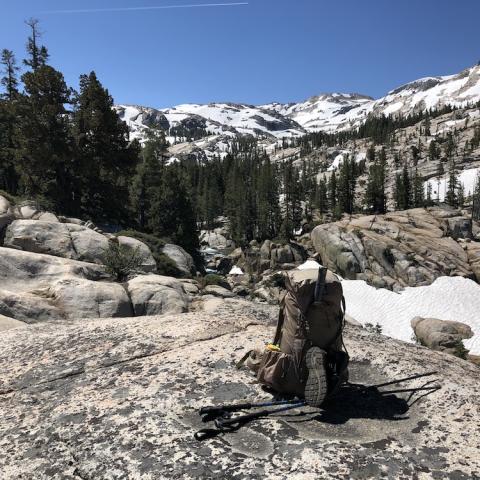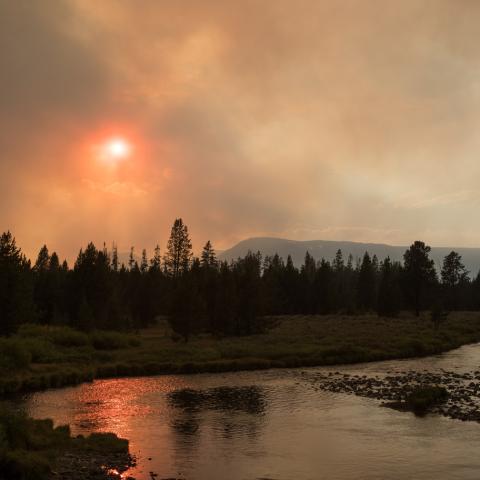
A 10-year-old was bitten by bear in Yellowstone National Park on Thursday/NPS file
A 10-year-old boy was saved from more serious injury from a bear Thursday in Yellowstone National Park when his parents defended him with a dose of bear spray in the bruin's face from five feet away, park officials said.
The family of four, from Washington state, was hiking up the Divide Trail southeast of the Old Faithful complex about 10 a.m. when the bear charged out of vegetation towards the family, according to the park. The boy ran from the bear, and it chased after him and knocked him to the ground.
"The parents effectively deployed bear spray about five feet from the bear’s face. Thereafter, the bear shook its head and left the area," a park release said. "After the incident, the family walked back to the trailhead, drove to the Old Faithful Ranger Station, and were directed to the nearby clinic. The 10-year-old suffered an injured wrist, puncture wounds to the back, and wounds around the buttocks. He was transferred to the Big Sky Medical Center."
Law enforcement and bear management staff responded immediately to the area and were trying to determine whether a black or grizzly bear was involved in the incident. The Spring Creek and Divide trails were temporarily closed.
Park staff pointed out that all of Yellowstone is bear habitat: "from the deepest backcountry to the boardwalks around Old Faithful." Visitors should be prepared to encounter bears anywhere in the park, they added.
There has not been a reported bear attack in Yellowstone since 2015. On average, one bear attack per year occurs in the park, the staff noted.




 Support Essential Coverage of Essential Places
Support Essential Coverage of Essential Places







Comments
in that kind of encounter, should the boy not ran? I don't know a lot about what the best thing to do is, but Ibam thinking we should not run..is this correct..thank goodness they had bearvsprsyband it worked...
Gail - One must never run froma bear. That is rule number one.
Most ten year olds will either freeze in place or run like the dickens. Congrats to parents for both having the bearspray and in using it. No doubt the entire incident was over in less than a minute or so.
Absolutely NOT. Never run from a bear. You get together, act big, speak calmly, and slowly back away. In the case of a charging bear, hikers are encouraged to wear a backpack/day pack. Roll up in a ball and defend the head and neck. Parents did the right thing carrying bear spray.
My husband and I love hiking out in non-populated areas and have been to Yellowstone, Glacier, Kodiak, Alaska and we always carry bear spray or have guide with weapon go with us. We leave the unused bear spray at the check in of any lodge or bed and breakfast we stay so that others who may not be able to afford it can use it. We've only encountered Kodiak Bears when in Alaska and while my husband and I were photographing them (they came to us) the guide calmly took his rifle off his shoulder, got it ready, talked calmly to them and they promptly left. Bears won't usually attack unless they're hungry and have no food for awhile, defending their young, or frightened when surprised (usually by hikers). Many people wear bells on their backpacks or day packs or shoes to produce noise that will deter the bear. They don't want to encounter you any more than you do them.
"How could you tell the bear was eating hikers?"
"By the sleigh bells in his scat."
No, you are not suppose to run when you see a bear but your natural instinct is to run. When you are surprised by a bear you think RUN. Three times I have encountered brown bears up close at the Russian River in Alaska. All three times I ran... from the camp site into a motorhome, from the water onto a gravel bar where there were people, and one time when I was fishing alone and standing in the water a brown bear came up river behind me. Someone on the path warned me, and I ran toward shore. When I did the bear ran toward me. When I stopped, she stopped. I dropped my rod on the gravel bar and pulled out my bear spray. I left my two salmon on my stringer. I backed the rest of the way out of the water very slowly. The bear proceeded to eat my two fish and gnaw on the cork butt of my fly fishing rod before she went up river. Don't run if you can make yourself stop because they will charge. Thank goodness the parents had bear spray. It is expensive but so worth a life.
Never, ever run. Bear will perceive you as prey.